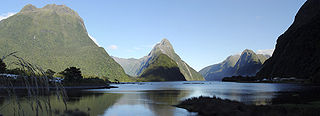
Milford Sound is a fiord in the south west of New Zealand's South Island within Fiordland National Park, Piopiotahi Marine Reserve, and the Te Wahipounamu World Heritage site. It has been judged the world's top travel destination in an international survey and is acclaimed as New Zealand's most famous tourist destination. Rudyard Kipling called it the eighth Wonder of the World. The fiord is most commonly accessed via road by tour coach, with the road terminating at a small village also called Milford Sound.

Fiordland is a geographical region of New Zealand in the south-western corner of the South Island, comprising the westernmost third of Southland. Most of Fiordland is dominated by the steep sides of the snow-capped Southern Alps, deep lakes, and its steep, glacier-carved and now ocean-flooded western valleys. The name "Fiordland" comes from a variant spelling of the Scandinavian word for this type of steep valley, "fjord". The area of Fiordland is dominated by, and very roughly coterminous with, Fiordland National Park, New Zealand's largest National Park.

Fiordland National Park is a national park in the south-west corner of South Island of New Zealand. It is the largest of the 13 national parks in New Zealand, with an area covering 12,607 km2 (4,868 sq mi), and a major part of the Te Wāhipounamu a UNESCO World Heritage Site established in 1990. The park is administered by the Department of Conservation. The southern ranges of the Southern Alps cover most of Fiordland National Park, combined with the deep glacier-carved valleys.

Sir Thomas Mackenzie was a Scottish-born New Zealand politician and explorer who briefly served as the 18th prime minister of New Zealand in 1912, and later served as New Zealand High Commissioner in London.
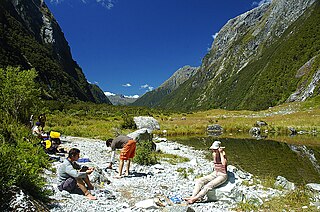
The Milford Track is a hiking route in New Zealand, located amidst mountains and temperate rain forest in Fiordland National Park in the southwest of the South Island. The 53.5 km (33.2 mi) hike starts at Glade Wharf at the head of Lake Te Anau and finishes in Milford Sound at Sandfly Point, traversing rainforests, wetlands, and an alpine pass.

Te Wairoa was a village close to the shore of Lake Tarawera near Rotorua, New Zealand. The village was buried by volcanic ash in the 1886 eruption of Mount Tarawera. It was later excavated and is now open as a tourist destination, the Buried Village. The nearby Wairere Falls are also a tourist destination.

The Kaituna River is in the Bay of Plenty region of the North Island of New Zealand. It is the outflow from Lakes Rotorua and Rotoiti, and flows northwards for 45 kilometres (28 mi), emptying into the Bay of Plenty near Te Puke. It was the subject of a claim concerning the effluent flowing down the river from Lake Rotorua, which resulted in movement to a land treatment system.
Lake Waikareiti, also spelt Lake Waikare Iti, is located in Te Urewera National Park in the North Island of New Zealand. A number of hiking trails are found within the catchment basin of the lake.

Mitre Peak is a mountain in the South Island of New Zealand, located on the shore of Milford Sound.

Lake Marian is an alpine lake at the southern end of the Darran Mountains in the Fiordland National Park in the South Island of New Zealand. The lake is located just above the treeline in a hanging valley leading northwest from the Hollyford Valley near The Divide pass. The valley is sheltered by steep snow-covered peaks of over 2,000 metres (6,600 ft) on all sides apart from the entrance.
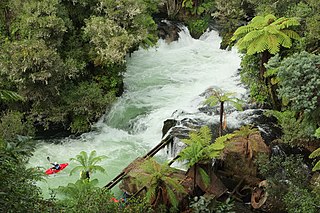
Okere Falls is a small town located 21 km from Rotorua on SH 33 between Rotorua and Tauranga on the North Island of New Zealand. The town is situated on the shore of the Okere Inlet of Lake Rotoiti, from which the Kaituna River flows north towards the Bay of Plenty.
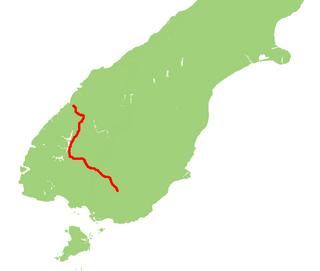
State Highway 94 is a New Zealand state highway connecting the large Southland town of Gore with one of New Zealand's most popular destinations, Milford Sound. It also passes the significant townships of Lumsden and Te Anau as well going through the Homer Tunnel. The road also goes through Fiordland and crosses the Main Divide of the Southern Alps.

The Rainbow Falls, Māori name Waianiwaniwa,, are a single-drop waterfall located on the Kerikeri River near Kerikeri in New Zealand.

Water is relatively abundant in New Zealand due to the temperate climate and maritime weather patterns. In recent years, water pollution and draw-down of aquifers have become important environmental issues in New Zealand.
Sutherland Sound is a fiord of the South Island of New Zealand. It is the smallest of the fiords that make up the coast of Fiordland, and the only one with limited sea access. It is the second most northerly of the fiords, 22 kilometres southwest of Milford Sound / Piopiotahi and eight kilometres northeast of Hāwea / Bligh Sound. The fiord is ten kilometres in length and the Light River and the Dark River flow into the eastern end. The fiord is composed of two main sections - a large bay opening into the sea, and a more traditional fiord as the inner section. These are separated by a narrow channel less than 100 metres (330 ft) wide at its narrowest point.

Milford Sound is a small village located deep within Fiordland National Park in the Southland Region of New Zealand. It is located at the head of the fiord also called Milford Sound. The village and fiord are one of the most visited places in New Zealand, receiving about one million day visitors per year.

Lake Quill is a tarn located in New Zealand's Fiordland National Park at 979 m above sea level. The cirque lake of approximately 1.2 km2 is the source of Sutherland Falls, one of the highest waterfalls in the country and seventh-highest in the world, cascading from Lake Quill in three tiers into the Arthur Valley alongside the Milford Track, approximately 20 km from Milford Sound.

Donald Sutherland was a Scottish-born New Zealand explorer, active in the late 19th century. Born in Wick, he served as a soldier in the Expedition of the Thousand, led by Giuseppe Garibaldi, in the Italian unification wars. Soon afterwards he travelled to New Zealand where he prospected for gold in Otago. He later joined the New Zealand military and fought in a number of engagements of the New Zealand Wars. In 1877, he settled in Milford Sound and lived as a hermit for a number of years, exploring the region. He later married and, with his wife, ran an accommodation facility for the increasing number of tourists visiting Milford Sound until his death in October 1919. The Sutherland Falls, located near Milford Sound and the highest waterfall in New Zealand, is named for him.
Te Hapua Marine Reserve is a marine reserve covering an area of 449 hectares of Te Hāpua / Sutherland Sound, in Fiordland on New Zealand's South Island. It was established in 2005 and is administered by the Department of Conservation.
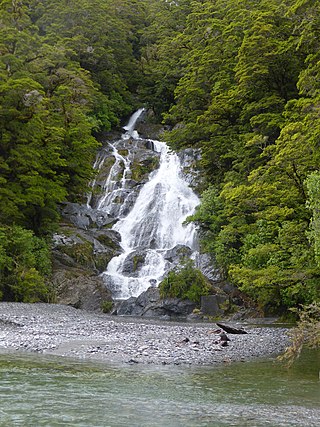
Fantail Falls is a waterfall in Mount Aspiring National Park, Westland District, New Zealand.


















